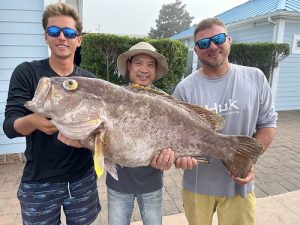A new Maryland state fishing record was set when Jian Feng Li of Montgomery County, Maryland, caught a yellowedge grouper on August 27. This impressive fish was caught in the deep waters off Ocean City, specifically in Poorman’s Canyon, marking the first time this species has entered Maryland’s fishing records.
The yellowedge grouper, known for its distinctive yellow, bulging eyes and bright yellow fin edges, is typically found in waters ranging from North Carolina to Brazil, including the Gulf of Mexico and the Caribbean. However, it has occasionally been caught by deep-dropping anglers off the coasts of New Jersey, Maryland, and Virginia.
Deep-dropping is a fishing technique where bait is lowered to depths of 400 to 600 feet, often requiring electric reels due to the effort involved in retrieving the line. On this occasion, Li, fishing aboard Captain Chase Eberle’s charter boat, Tiderunner, used a hand-cranked reel to bring in the record-breaking grouper, while other anglers in the group lost their hooked fish.

Weighing in at 38 pounds and measuring 43 inches long, the yellowedge grouper was weighed on a certified scale at Sunset Marina in Ocean City. Maryland Department of Natural Resources (DNR) biologists later confirmed the species, adding it to the state’s Atlantic division fishing records. While Li’s catch was remarkable, it fell just short of the International Game Fish Association’s world record, a 48.6-pound yellowedge grouper caught off Dauphin Island, Alabama, in 2012.
Yellowedge grouper, which inhabit depths of 290 to 1,200 feet, are known for their culinary appeal. Their white, flaky meat is praised for retaining more moisture than other fish, with a flavor often compared to halibut or bass. Bait commonly used to catch these fish includes chub mackerel, sardine, squid, and white octopus, as the species feeds on a variety of invertebrates and fish.
For anglers who think they may have landed a record catch in Maryland, the DNR recommends filling out a state record application and calling their hotline. To preserve the fish’s weight until it can be verified, the DNR advises keeping it immersed in ice water until it can be checked and certified.
Image/Source: chesapeakebaymagazine





